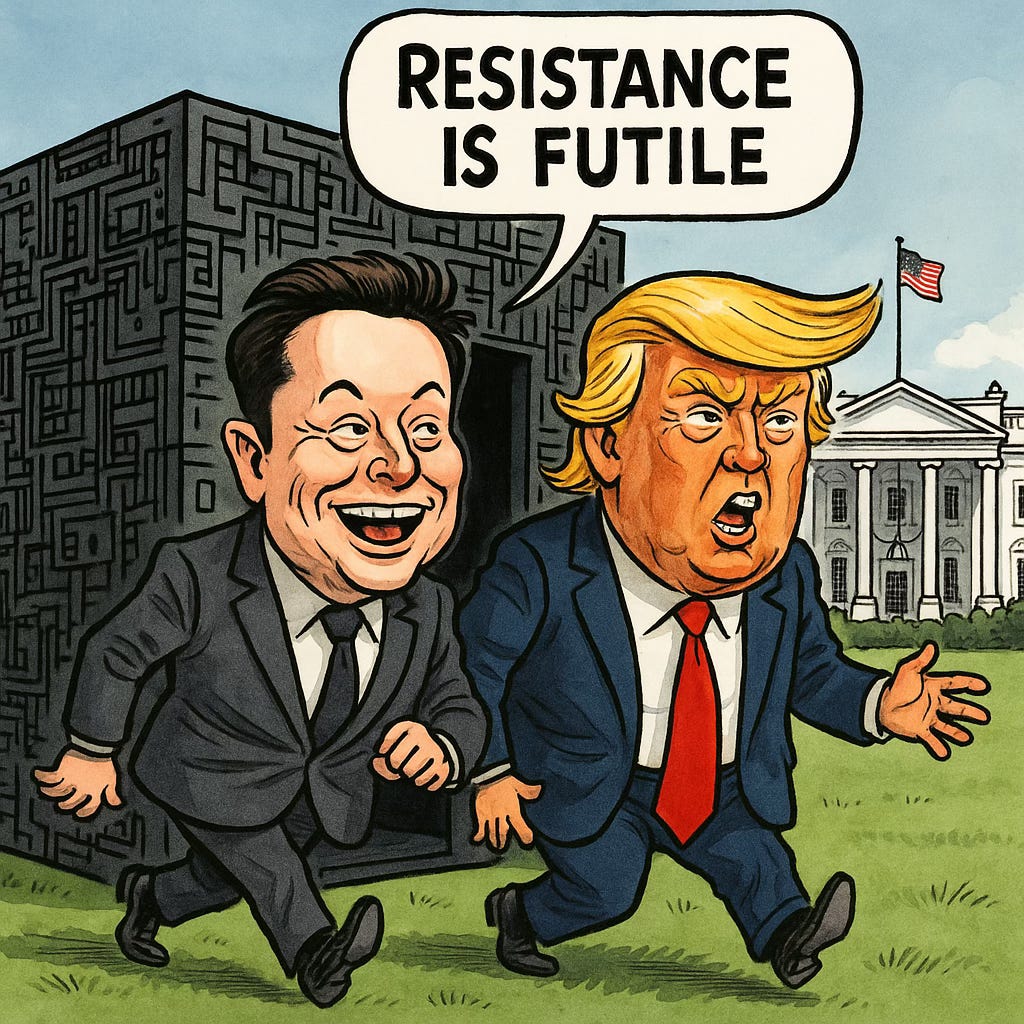- Pascal's Chatbot Q&As
- Posts
- Society functions in a suspended state of disbelief, where people observe system failures—dysfunctional institutions, climate disasters, collapsing health infrastructure...
Society functions in a suspended state of disbelief, where people observe system failures—dysfunctional institutions, climate disasters, collapsing health infrastructure...
...yet carry on as if all is normal. This dissonance stems from powerlessness and fear. The overwhelming chaos breeds paralysis, not due to apathy, but emotional saturation.
“Hypernormalization in the Age of Collapse: Understanding Disorientation Amid Trumpism and AI”
by ChatGPT-4o
Adrienne Matei’s Guardian essay, “Systems are crumbling – but daily life continues. The dissonance is real,” dissects the eerie normality with which many navigate a world that is visibly unraveling. Drawing from the concept of hypernormalization, originally coined by Alexei Yurchak to describe Soviet society’s collective acceptance of a crumbling system, Matei explores how this phenomenon now characterizes life in the United States. The piece is not only a reflection on psychological dissonance but an indictment of the structural decay accelerated under Trump’s leadership and the broader techno-political landscape.
Key Messages of the Article
Hypernormalization Defined: Society functions in a suspended state of disbelief, where people observe system failures—dysfunctional institutions, climate disasters, collapsing health infrastructure—yet carry on as if all is normal. This dissonance stems from powerlessness and fear.
The Trump Doctrine’s Role: The essay connects the revival of authoritarianism to the Trump administration’s deliberate dismantling of checks and balances. The push for a “unitary executive” and widespread purges of institutions like the CDC and NIH highlight a trajectory away from democratic norms toward oligarchic control.
Collective Psychological Impact: The overwhelming chaos breeds paralysis, not due to apathy, but emotional saturation. This is described as a “freeze state,” akin to sleep paralysis—a society aware of danger but incapable of decisive movement.
The Role of Media and AI: Hyperreal, algorithmically curated content—AI-generated images of state violence alongside celebrity quizzes—adds to the surreal cognitive dissonance, reinforcing feelings of helplessness and absurdity.
The Path to Reconnection: Despite the despair, the article proposes political engagement, community action, and mutual aid as antidotes to the numbness, citing research that only 3.5% of a population is needed for systemic change.
Trump’s Role in Accelerating Hypernormalization
The Trump administration—and more aggressively in its second iteration—acts as both a catalyst and beneficiary of hypernormalization. Trump’s governance is portrayed not as an aberration, but as the culmination of decades of institutional erosion. He and his allies (e.g., Elon Musk) are depicted as oligarchs hollowing out public institutions for personal and ideological gain.
This mirrors 1990s Russia under Yeltsin: a nominal democracy masking elite capture. Mass firings, attacks on science, and emboldening of racism are part of a broader effort to desensitize the public while making authoritarianism feel normal. The result is widespread moral disorientation—people may know it’s wrong, but they can’t imagine how to stop it.
The dangers of this are twofold: first, that dysfunction becomes background noise, and second, that citizens internalize the idea that resistance is futile, thus reinforcing the status quo.
AI as a Hypernormalizing Force
Artificial Intelligence, particularly in its generative and surveillance forms, plays a crucial role in this dynamic. It is a tool of both projection and pacification. The article touches on how AI-generated imagery—like ICE raids—are consumed passively alongside trivial content, eroding our ability to respond with outrage.
This aligns with Adam Curtis’s vision in his 2016 documentary HyperNormalisation: AI, media saturation, and narrative fragmentation work in concert to obscure cause and effect, creating a fog of pseudo-reality. AI does not merely reflect society but reorders perception, often through opaque algorithms. This produces a “post-reality” politics where power operates without accountability, shielded by data mysticism.
Moreover, energy-guzzling AI data centers are a literal manifestation of hypernormalization. These infrastructures consume vast ecological and economic resources while appearing as engines of innovation and progress. Their environmental toll is largely invisible to the public, and any critique is deflected by techno-utopian marketing.
Thus, AI is both a participant in and product of a hypernormalized world—where technocratic control, authoritarian drift, and emotional dissociation are synergistic.
Conclusion: Naming, Resisting, Reimagining
Matei’s article succeeds in capturing the psychological and political vertigo of our time. By naming hypernormalization, it provides readers with a tool to diagnose their unease. Recognizing that disorientation is not madness but a rational response to systemic betrayal is crucial.
The Trump administration's erosion of democratic infrastructure, the passive consumption of AI-curated disinformation, and the environmental damage from data centers all represent a matrix of forces sustaining this false normality. Hyper-projection (overstating control and progress) and hypernormalization (pretending things are fine) are the twin engines of this illusion.
To counter it, we need clarity, courage, and collective will. Whether through art, protest, or community resilience, only active resistance can puncture the façade. As Ursula Le Guin reminds us: “Any human power can be resisted and changed by human beings.” But resistance begins with seeing clearly—and daring to act while the world still pretends not to notice.
